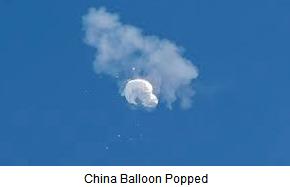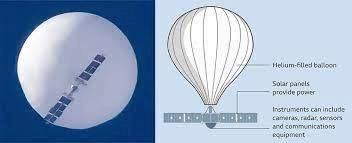 Media was dominated this past week by the appearance and then destruction of the mystery balloon launched by China that floated across our Nation in the high stratosphere. Most of the questions and commentary related to the information gathering potential of the 200 foot diameter (31,400 cubic feet capacity) balloon with attached solar array, propulsion system and an instrument package. The belated explanation from China that the balloon was for meteorologic research is obviously fallacious. Examination of the debris recovered off the coast of South Carolina should indicate the purpose and capabilities of the craft.
Media was dominated this past week by the appearance and then destruction of the mystery balloon launched by China that floated across our Nation in the high stratosphere. Most of the questions and commentary related to the information gathering potential of the 200 foot diameter (31,400 cubic feet capacity) balloon with attached solar array, propulsion system and an instrument package. The belated explanation from China that the balloon was for meteorologic research is obviously fallacious. Examination of the debris recovered off the coast of South Carolina should indicate the purpose and capabilities of the craft.
China can survey the U. S. using satellites. So, the mid-week contention that the balloon and its electronic package represented no adverse affect is acceptable only at face value. The purpose of the craft raises questions as to motive, since China does nothing of this intrusive nature by accident and the purpose of the incursion has yet to be explained.
With the preoccupation over the craft gathering information, one must also consider the balloon as a potential weapon delivery system. China has now effectively demonstrated that it can deploy a transport device that will generally follow the jet stream, in a path that is entirely predictable over a short period of time and can also implement limited maneuverability, especially in the vertical plane. This said, the balloon represents an outstanding delivery system for a biological weapon with implications for the health of humans and livestock. A controlled balloon could descend from the stratosphere to a lower altitude and release one or more biological agents.
 Given the current situation, China and some of its allies are now somewhat confident that a balloon can be weaponized at low cost to deliver a radiologic or biological package that extends beyond the capability of a low-orbit satellite. Setting aside the national pride and military readiness aspects of intrusion into U.S. air space, sophisticated balloons emanating from China represent both the potential for gathering information but also delivering a weapon.
Given the current situation, China and some of its allies are now somewhat confident that a balloon can be weaponized at low cost to deliver a radiologic or biological package that extends beyond the capability of a low-orbit satellite. Setting aside the national pride and military readiness aspects of intrusion into U.S. air space, sophisticated balloons emanating from China represent both the potential for gathering information but also delivering a weapon.
Students of military history will recollect the effort by Japan during the waning years of WWII to deploy 9,000 balloons with incendiary devices with the objective of igniting forest fires in northwest states. The crude weapons were decidedly ineffective, having killed one a family in Oregon and started a few fires but they established the functionality of a low-cost remotely deployed unmanned weapon.
Lest we become too self-righteous over aerial surveillance in our air space, it must be remembered that in 1960 a U-2 aircraft piloted by Francis Gary Powers, a CIA employee, was shot down over Sverdlosk while undertaking a secret spy mission gathering information on Soviet missile installations. The incident resulted in the cancellation of a bilateral summit in Geneva, reminiscent of the decision by Secretary of State Blinken to delay a scheduled visit to China.
There is speculation as to whether balloons have previously entered U.S. airspace. Emerging reports suggest that China has conducted over-flights in 40 nations as part of a comprehensive and aggressive program of surveillance. Irrespective of whether or not baloons from China have passed over U.S. territory, the U.S. must now enhance NORAD capabilities to detect and destroy any future craft launched by China the instant they enter U.S. airspace. China is an adversarial nation in the context of defense and national security